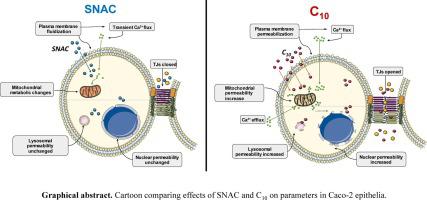当前位置:
X-MOL 学术
›
Eur. J. Pharm. Biopharm.
›
论文详情
Our official English website, www.x-mol.net, welcomes your
feedback! (Note: you will need to create a separate account there.)
A head-to-head Caco-2 assay comparison of the mechanisms of action of the intestinal permeation enhancers: SNAC and sodium caprate (C10).
European Journal of Pharmaceutics and Biopharmaceutics ( IF 4.4 ) Pub Date : 2020-05-05 , DOI: 10.1016/j.ejpb.2020.04.023 Caroline Twarog 1 , Kai Liu 2 , Peter J O'Brien 3 , Kenneth A Dawson 2 , Elias Fattal 4 , Brigitte Illel 5 , David J Brayden 1
European Journal of Pharmaceutics and Biopharmaceutics ( IF 4.4 ) Pub Date : 2020-05-05 , DOI: 10.1016/j.ejpb.2020.04.023 Caroline Twarog 1 , Kai Liu 2 , Peter J O'Brien 3 , Kenneth A Dawson 2 , Elias Fattal 4 , Brigitte Illel 5 , David J Brayden 1
Affiliation

|
Salcaprozate sodium (SNAC) and sodium caprate (C10) are the two leading intestinal permeation enhancers (PEs) in oral peptide formulations in clinical trials. There is debate over their mechanism of action on intestinal epithelia. The aims were: (i) to compare their effects on the barrier function by measuring transepithelial electrical resistance (TEER), permeability of FITC-4000 (FD4) across Caco-2 monolayers, and on immunohistochemistry of tight junction (TJ)-associated proteins; and (ii) to compare cellular parameters using conventional end-point cytotoxicity assays and quantitative high content analysis (HCA) of multiple sub-lethal parameters in Caco-2 cells. C10 (8.5 mM) reversibly reduced TEER and increased FD4 permeability across monolayers, whereas SNAC had no effects on either parameter except at cytotoxic concentrations. C10 exposure induced reorganization of three TJ proteins, whereas SNAC only affected claudin-5 localization. High concentrations of C10 and SNAC were required to cause end-point toxicology changes in vitro. SNAC was less potent than C10 at inducing lysosomal and nuclear changes and plasma membrane perturbation. In parallel, HCA revealed that both agents displayed detergent-like features that reflect initial membrane fluidization followed by changes in intracellular parameters. In conclusion, FD4 permeability increases in monolayers in response to C10 were in the range of concentrations that altered end-point cytotoxicity and HCA parameters. For SNAC, while HCA parameters were also altered in a similar overall pattern as C10, they did not lead to increased paracellular flux. These assays show that both agents are primarily surfactants, but C10 has additional TJ-opening effects. While these in vitro assays illucidate their epithelial mechanism of action, clinical experience suggests that they over-estimate their toxicology in the dynamic intestinal environment.
中文翻译:

肠道渗透促进剂SNAC和癸酸钠(C10)作用机理的头对头Caco-2分析比较。
Salcaprozate钠(SNAC)和癸酸钠(C10)是临床试验中口服肽制剂中两种主要的肠渗透促进剂(PEs)。关于它们对肠上皮细胞的作用机制存在争议。目的是:(i)通过测量跨上皮电阻(TEER),FITC-4000(FD4)跨Caco-2单层的通透性以及紧密连接(TJ)相关蛋白的免疫组织化学,比较它们对屏障功能的影响。 ; (ii)使用常规终点细胞毒性分析和Caco-2细胞中多个亚致死参数的定量高含量分析(HCA)比较细胞参数。C10(8.5 mM)可逆地降低了TEER并增加了跨单层的FD4渗透性,而SNAC除了在细胞毒性浓度下对这两个参数均无影响。C10暴露诱导三种TJ蛋白的重组,而SNAC仅影响claudin-5的定位。需要高浓度的C10和SNAC才能在体外引起终点毒理学变化。SNAC在诱导溶酶体和核变化以及质膜扰动方面的效力不及C10。同时,HCA揭示了这两种试剂均显示出类似洗涤剂的特征,反映了最初的膜流化作用以及随后细胞内参数的变化。总之,响应于C10的单层FD4通透性增加处于改变终点细胞毒性和HCA参数的浓度范围内。对于SNAC,虽然HCA参数也以与C10相似的整体模式进行了更改,但它们并未导致细胞旁通量的增加。这些测定表明这两种试剂主要是表面活性剂,但是C10具有其他TJ开放效果。尽管这些体外试验阐明了它们的上皮作用机制,但临床经验表明,它们在动态肠道环境中高估了其毒理学。
更新日期:2020-05-06
中文翻译:

肠道渗透促进剂SNAC和癸酸钠(C10)作用机理的头对头Caco-2分析比较。
Salcaprozate钠(SNAC)和癸酸钠(C10)是临床试验中口服肽制剂中两种主要的肠渗透促进剂(PEs)。关于它们对肠上皮细胞的作用机制存在争议。目的是:(i)通过测量跨上皮电阻(TEER),FITC-4000(FD4)跨Caco-2单层的通透性以及紧密连接(TJ)相关蛋白的免疫组织化学,比较它们对屏障功能的影响。 ; (ii)使用常规终点细胞毒性分析和Caco-2细胞中多个亚致死参数的定量高含量分析(HCA)比较细胞参数。C10(8.5 mM)可逆地降低了TEER并增加了跨单层的FD4渗透性,而SNAC除了在细胞毒性浓度下对这两个参数均无影响。C10暴露诱导三种TJ蛋白的重组,而SNAC仅影响claudin-5的定位。需要高浓度的C10和SNAC才能在体外引起终点毒理学变化。SNAC在诱导溶酶体和核变化以及质膜扰动方面的效力不及C10。同时,HCA揭示了这两种试剂均显示出类似洗涤剂的特征,反映了最初的膜流化作用以及随后细胞内参数的变化。总之,响应于C10的单层FD4通透性增加处于改变终点细胞毒性和HCA参数的浓度范围内。对于SNAC,虽然HCA参数也以与C10相似的整体模式进行了更改,但它们并未导致细胞旁通量的增加。这些测定表明这两种试剂主要是表面活性剂,但是C10具有其他TJ开放效果。尽管这些体外试验阐明了它们的上皮作用机制,但临床经验表明,它们在动态肠道环境中高估了其毒理学。


















































 京公网安备 11010802027423号
京公网安备 11010802027423号